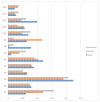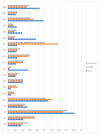Evaluating Drivers of the Patient Experience Triangle: Stress, Anxiety, and Frustration
- PMID: 37047998
- PMCID: PMC10094497
- DOI: 10.3390/ijerph20075384
Evaluating Drivers of the Patient Experience Triangle: Stress, Anxiety, and Frustration
Abstract
Patient experience is a widely used indicator for assessing the quality-of-care process during a patient's journey in hospital. However, the literature rarely discusses three components: patient stress, anxiety, and frustration. Furthermore, little is known about what drives each component during hospital visits. In order to explore this, we utilized data from a patient experience survey, including patient- and provider-related determinants, that was administered at a local hospital in Abu Dhabi, UAE. A machine-learning-based random forest (RF) algorithm, along with its embedded importance analysis function feature, was used to explore and rank the drivers of patient stress, anxiety, and frustration throughout two stages of the patient journey: registration and consultation. The attribute 'age' was identified as the primary patient-related determinant driving patient stress, anxiety, and frustration throughout the registration and consultation stages. In the registration stage, 'total time taken for registration' was the key driver of patient stress, whereas 'courtesy demonstrated by the registration staff in meeting your needs' was the key driver of anxiety and frustration. In the consultation step, 'waiting time to see the doctor/physician' was the key driver of both patient stress and frustration, whereas 'the doctor/physician was able to explain your symptoms using language that was easy to understand' was the main driver of anxiety. The RF algorithm provided valuable insights, showing the relative importance of factors affecting patient stress, anxiety, and frustration throughout the registration and consultation stages. Healthcare managers can utilize and allocate resources to improve the overall patient experience during hospital visits based on the importance of patient- and provider-related determinants.
Keywords: machine learning; patient anxiety; patient data; patient experience; patient frustration; patient satisfaction; patient stress; quality; random forest.
Conflict of interest statement
The authors declare no conflict of interest.
Figures
References
-
- Simsekler M.C.E., Qazi A., Alalami M.A., Ellahham S., Ozonoff A. Evaluation of patient safety culture using a random forest algorithm. Reliab. Eng. Syst. Saf. 2020;204:107186. doi: 10.1016/j.ress.2020.107186. - DOI
Publication types
MeSH terms
LinkOut - more resources
Full Text Sources
Medical



